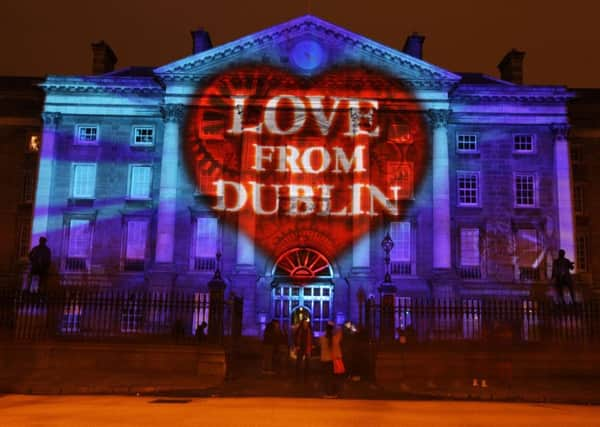Travel: Dublin, Ireland


One of the strangest and most joyous experiences I’ve had in recent months involved half-walking, half-dancing through the streets of central Dublin with a lamp on a stick on a damp winter night. Luxe, the group that organises the famous Procession of Light, kindly allowed us to take part in this happy display and there we were, trotting behind dozens of colourful official performers and floats through main streets and cobbled lanes lined with excited children and their families.
That twinkly family atmosphere changed hue after a few hours as the kids got tucked in to bed at home and the party people emerged, flooding this pretty city with laughter and a mission to have fun as 2014 became 2015. And don’t let anyone claim otherwise (not that they would): Dubliners really do know how to have fun. At a special concert in College Green, bands including The Dublin Legends and Kodaline helped usher in the new year and everyone was just as jolly as you’d expect.
Advertisement
Hide AdAdvertisement
Hide AdDublin deserves its reputation for being a sociable place – and it isn’t all about the Guinness, honest. The smoking ban was introduced here before anywhere else nearby, and people have responded creatively, designing lots of heated outdoor spaces with seating and canopies outside bars and restaurants.
While this might not be exactly what those looking out for the nation’s health had in mind, the result is a very European-looking city centre with a thriving café/pavement culture.
There are some fabulous bars and restaurants. One of the most unusual dining destinations was Sophie’s Restaurant (thedean.ie/eat-drink/sophies), on the top floor of the Dean Hotel on Harcourt Street. With windows all around, it affords great views of the city, and splashes of greenery and the odd tree inside give it an unexpectedly verdant vibe. Also of note for foodies is Cleaver East (cleavereast.ie) on Essex Street, where food is creatively prepared, and served in a buzzing environment. Another great spot for a drink and a snack is The Church (www.thechurch.ie), a beautiful conversion of St Mary’s, which closed in the 1960s. It’s all about high ceilings, dark wood, twinkly lights and fun.
But it would be a mistake to visit Dublin and spend the entire time eating and drinking, and not only because it’s fairly pricey. We spent as much time as we could checking out the museums, and I fell completely in love with the Little Museum of Dublin (www.littlemuseum.ie) on St Stephen’s Green. A lot of people visit because of the permanent U2 exhibition, which is a collection of items related to the mega-band, but there is so much more to it than this. Arranged in a Georgian former home, it aims to tell the social story of 20th century Dublin.
It has everything from an early copy of Ulysses (open to the back page, so you can claim to be one of the few people to have got to the end of it) to political documents relating to the Easter Rising and hundreds of wonderful photographs and posters from this most eventful of centuries. Do ask to join a tour if you can, as the staff’s passion for their subject at this enchanting museum really does bring it all alive.
2015 is the year of Irish design (www.irishdesign2015.ie), the aim being to promote, explore and celebrate Irish designers of all descriptions. One of the most fascinating and accessible elements of this was a small show called In the Making at the Coach House museum next to Dublin Castle.
Curated for London’s Design Museum, its displays include everyday items that are half-way through the production process, such as half-finished marbles, pencils and sports shoes. I could have spent the whole day there. This show will soon tour the country, so catch it wherever you can.
Just round the corner is the Chester Beatty Library (www.cbl.ie), a wonderful spot housing the vast collection of the “King of Copper”, Alfred Chester Beatty, an American mining millionaire who became an honorary Irish citizen in the 1950s. The treasures include vast amounts of Oriental pieces, and the Silk Road Cafe, beside an attractive, airy atrium, serves some tantalising Middle Eastern bites to help you charge up your museum-walking batteries.
Advertisement
Hide AdAdvertisement
Hide AdAnother jewel in Dublin’s cultural crown is the RHA (Royal Hibernian Academy) Gallery (www.rhagallery.ie) on Ely Place, an impressive space which showcases contemporary Irish and international contemporary art.
We stayed at the four-star Brooks Hotel, which, on Drury Street, is incredibly central but quiet enough to feel peaceful and friendly. Having nearly everything – from the Liffey cutting through the city, to the social hub of Temple Bar, to the shopping district around Grafton Street, and the trendier Camden and Portobello areas – within walking distance really does help you to fall for this gem of a city in no time.
• Brooks Hotel, 59-63 Drury Street, Dublin 2, tel: 035 1 7670 4000, www.brookshotel.ie; from €145 per night with breakfast.
FOLLOW US
SCOTSMAN TABLET AND MOBILE APPS